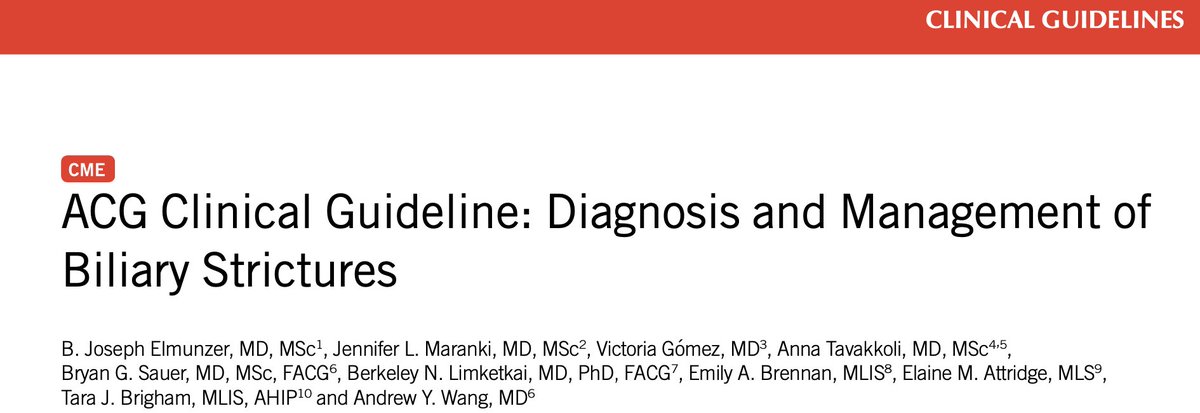
1/15
📢The recent ACG Guidelines on biliary strictures
👉Focus on DRAINAGE principles
🔥A Tweetorial #GITwitter @AmJGastro
📢The recent ACG Guidelines on biliary strictures
👉Focus on DRAINAGE principles
🔥A Tweetorial #GITwitter @AmJGastro

2/15
Goals of drainage
▶️to alleviate symptoms (when present),
▶️to reduce serum bilirubin for chemotherapy can be safely administered (typically 2.5–3.5 mg/dL) and
▶️to optimize surgical outcome
Goals of drainage
▶️to alleviate symptoms (when present),
▶️to reduce serum bilirubin for chemotherapy can be safely administered (typically 2.5–3.5 mg/dL) and
▶️to optimize surgical outcome
3/15
Extrahepatic stricture due to a benign condition,
👉fcSEMS over multiple plastic stents(MPS)
▶️12 months MPS or
▶️6 months fcSEMS,
🔥some evidence suggests 12 months of fcSEMS therapy is advantageous (exchange at 6 months).
Extrahepatic stricture due to a benign condition,
👉fcSEMS over multiple plastic stents(MPS)
▶️12 months MPS or
▶️6 months fcSEMS,
🔥some evidence suggests 12 months of fcSEMS therapy is advantageous (exchange at 6 months).
4/15
In patients with benign biliary stricture and GB in situ,
▶️MPS instead of fcSEMS
because of possible increased risk of acute cholecystitis (1%).
In patients with benign biliary stricture and GB in situ,
▶️MPS instead of fcSEMS
because of possible increased risk of acute cholecystitis (1%).
5/15 In extrahepatic stricture due to resectable pancreatic cancer or cholangiocarcinoma, the guidelines suggest
🚫AGAINST routine preoperative biliary drainage (conditional recommendation, low-quality evidence)
🚫AGAINST routine preoperative biliary drainage (conditional recommendation, low-quality evidence)
6/15
preoperative biliary drainage is warranted in --
👉those with acute cholangitis,
👉severe pruritus,
👉very high serum bilirubin levels, and
👉those undergoing neoadjuvant therapy or
👉delay to surgery (>2 weeks)
preoperative biliary drainage is warranted in --
👉those with acute cholangitis,
👉severe pruritus,
👉very high serum bilirubin levels, and
👉those undergoing neoadjuvant therapy or
👉delay to surgery (>2 weeks)
7/15
In patients with a malignant extrahepatic biliary stricture unresectable or borderline resectable,
▶️SEMS over PS placement
😖Insufficient to recommend for or against uSEMS vs fcSEMS
In patients with a malignant extrahepatic biliary stricture unresectable or borderline resectable,
▶️SEMS over PS placement
😖Insufficient to recommend for or against uSEMS vs fcSEMS
8/15 In patients with a malignant extrahepatic biliary stricture who are candidates for pancreaticoduodenectomy and undergo uSEMS placement
🎯Place proximal (upstream) end of the prosthesis at least 1.5 cm below biliary confluence.
🎯Place proximal (upstream) end of the prosthesis at least 1.5 cm below biliary confluence.
9/15
obstructive jaundice due to malignant perihilar stricture who are otherwise asymptomatic and who have declined or are not candidates for additional treatment,
🙅♂️Palliative drainage is NOT MANDATORY and decided on an case basis.
obstructive jaundice due to malignant perihilar stricture who are otherwise asymptomatic and who have declined or are not candidates for additional treatment,
🙅♂️Palliative drainage is NOT MANDATORY and decided on an case basis.
10/15
Perihilar stricture due to suspected malignancy,
😖insufficient to recommend for or against ERCP vs PTBD.
Perihilar stricture due to suspected malignancy,
😖insufficient to recommend for or against ERCP vs PTBD.
11/15
Perihilar stricture:
✅Drainage in a volumetric sectorial fashion and
🚫not in terms of unilateral vs bilateral.
🧐Goal is to drain 50% of nonatrophic liver,
with each sector contributing 1/3rd of liver’s volume
Perihilar stricture:
✅Drainage in a volumetric sectorial fashion and
🚫not in terms of unilateral vs bilateral.
🧐Goal is to drain 50% of nonatrophic liver,
with each sector contributing 1/3rd of liver’s volume
12/15
In patients with a malignant perihilar stricture,
😖insufficient to recommend for or against PS vs uSEMS placement.
🧐If SEMS is chosen for drainage, an effective drainage strategy using plastic stent should be proven first
In patients with a malignant perihilar stricture,
😖insufficient to recommend for or against PS vs uSEMS placement.
🧐If SEMS is chosen for drainage, an effective drainage strategy using plastic stent should be proven first
13/15
Malignant perihilar stricture due to cholangiocarcinoma who are not candidates for resection or transplantation
✅adjuvant endobiliary ablation ( PDT or RFA) plus plastic stent over plastic stent alone
Malignant perihilar stricture due to cholangiocarcinoma who are not candidates for resection or transplantation
✅adjuvant endobiliary ablation ( PDT or RFA) plus plastic stent over plastic stent alone
14/15 In patients with a biliary stricture, in whom ERCP was unsuccessful or impossible,
👉EUS-guided biliary access/drainage over PTBD,
✅based on fewer adverse events, when performed by an experienced endoscopists
👉EUS-guided biliary access/drainage over PTBD,
✅based on fewer adverse events, when performed by an experienced endoscopists
15/15 Thank you for reading this amazing work on @AmJGastro
Link for the full article
journals.lww.com/ajg/Fulltext/2…
Link for the full article
journals.lww.com/ajg/Fulltext/2…
@DrShubhamj @sanjy_med @drsridhars
@anupam_gastro @DrJimilShah @ShubhraMishra91 @amitava_gastro @DharJahnvi @Dr_AntrikshKr @ChhaganBirda @doctorboletoh @DrArunKValsan @drarupc @JhaDayakrishna
@anupam_gastro @DrJimilShah @ShubhraMishra91 @amitava_gastro @DharJahnvi @Dr_AntrikshKr @ChhaganBirda @doctorboletoh @DrArunKValsan @drarupc @JhaDayakrishna
• • •
Missing some Tweet in this thread? You can try to
force a refresh





